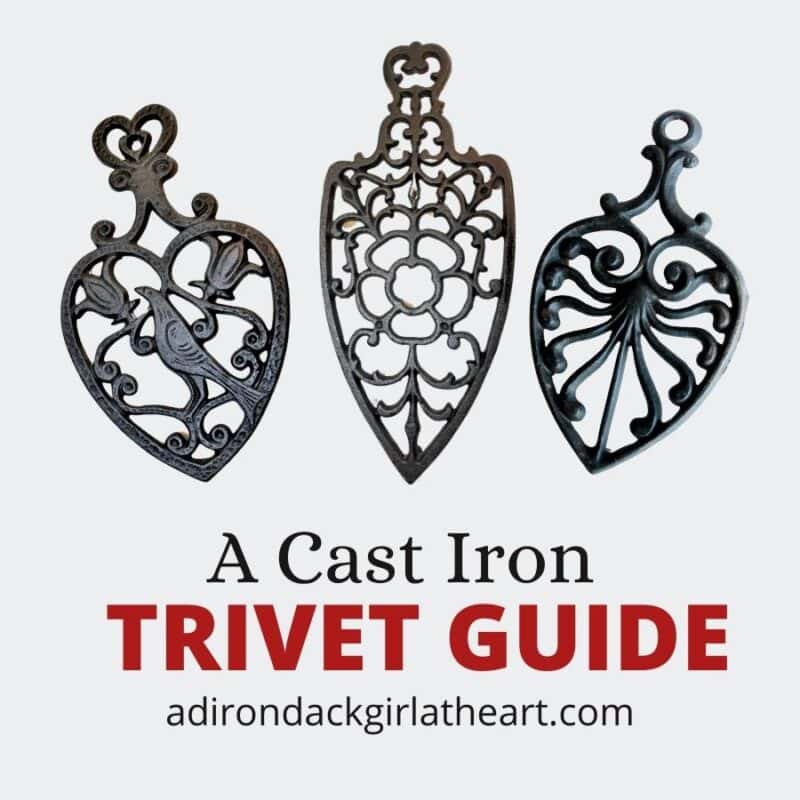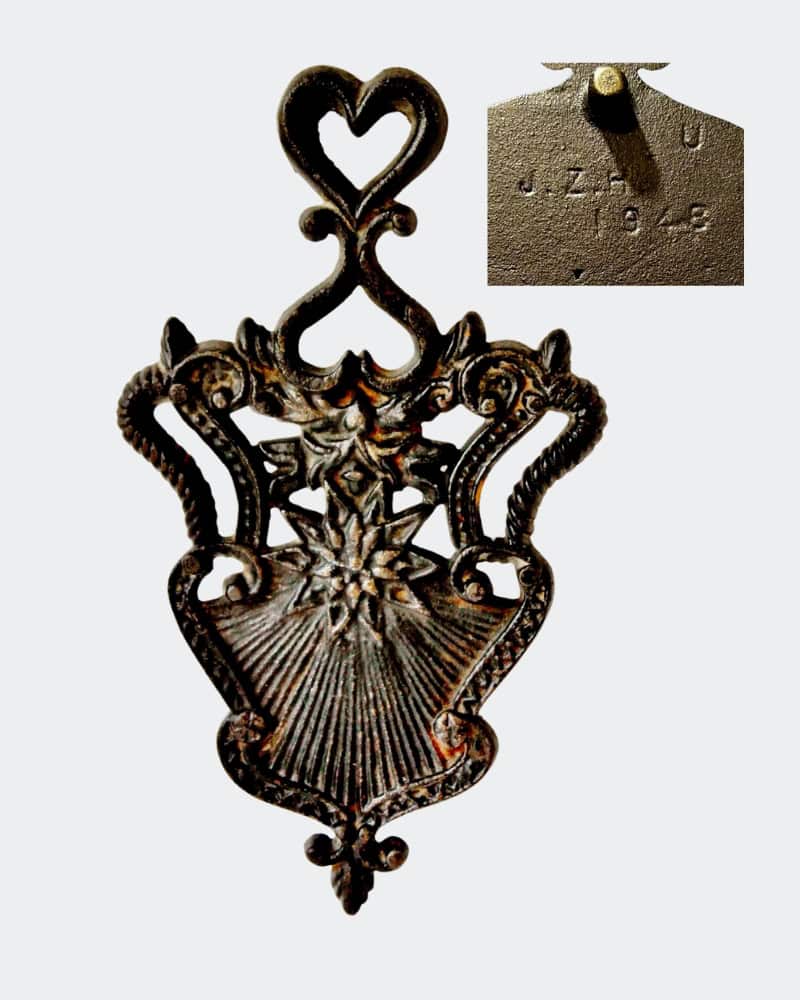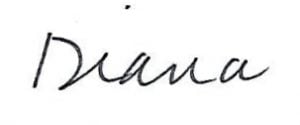A Cast Iron Trivet Guide With History & Values
Cast iron trivets are one of many colonial-era style collectibles that have amassed large followings a various times through the decades. Black trivets create quite a spectacular display when arranged decoratively on a wall. They appear as silhouettes, each a small piece of art featuring, hearts, eagles, flowers, and other design elements.
Unfortunately, as of the writing of this article, cast iron trivets are not as widely collected as they once were. That’s why #23 in my article, What Should I Collect? 41 Cheap & Plentiful Ideas, is trivets! Pick up vintage trivets while their popularity and prices are low.
All is not lost, however, read through to the end of the article to learn about cast metal motto trivets, which do sell well for me, over and over again.

Trivet History
Formed by pouring hot, molten iron into pre-made molds, early trivets were made as platforms for holding hot pots and pans or sad irons. Mid-1900 reproductions, on the other hand, served primarily as decorations.

The trivets that many of know and love today are a far cry from those you would have found back in America’s “olden days”. Those trivets were meant for heavy labor and made out of wrought iron. Their purpose? To allow for air flow under pots, pans, and kettles, thereby lowering the temperature of the contents.
Large trivets like the wrought iron one above would have been found next to the kitchen fireplace and would have been used as a “pot rest”.
In otherwords, after food had finished cooking in something like a cast iron pot of some sort, the cook would remove it from the fire and set it on a trivet to cool.
Homemakers used smaller trivets on the kitchen table to work in the same cooling way, but also to protect the table surface from burns.
Sad iron trivets, on the other hand, were intended to hold hot “sad irons”, which were used to remove wrinkles from clothing and bedding. With the discovery of electricity and invention of the electric iron in 1920, sad irons became obsolete. Today, many use them as door stops or book ends.
Round about the 1940’s multiple companies recognizing the decorative nature of trivets began to produce replicas of old designs. Since not all are marked, it has become nearly impossible to identify the makers of those unsigned trivets. Most, if not all, were made with short legs (approximately 5/8″) since they were intended for use as wall art.
Dating Cast Iron Trivets
Trivet Legs

One of the ways to determine if a trivet is older or newer is by measuring the length of its “leg”, that is, the three or four “prongs” on which it sits. Older trivet legs measure 1″ or longer.
Take the measurement from the top of the trivet to the tip of the foot, but don’t include any rail that might be present (Trivetology).
Casting Gates (Gate Marks)

Something else to look for in an antique trivet is a “casting gate” or “gate mark”, that is, a piece of ragged metal sticking out from the side. This would be where the trivet was broken off the mold.
Unfortunately, it is rare to find a truly antique trivet out in the wild but vintage examples abound.
Antique Cast Iron Trivet Examples

According to Margaret Lynn Rosack, author of The A-Z Guide to Collecting Trivets (2004), this piece is known as “Peacock” or “Tree of Life” and it dates to the mid to late 1800’s. She values it at $35.

It’s legs, from the top of the trivet to the bottom of the feet measure 1 1/2 inches.
Antique Sad Iron Trivets
Back in the day, wrinkles in clothing and bedding were pressed smooth with hot “sad irons”. Trivets made in the same triangular shape held the sad irons up off one’s ironing surface to prevent burns.
“Sad” is an Old English word that means “heavy, dense, and solid”, words definitely describing these weighty tools. A homemaker would typically own more than one, allowing a second iron to heat in the fire, ready for use when the first grew too cool.
I can only image the muscles one would develop using these heavy home appliances!

This (very common) “Enterprise Mfg Co, Philidelphia” sad iron trivet (6 1/4″ long) dates to the late 1870’s according to Rosack’s guide. You can see on the inset photo that it has longish legs measuring 1″.
In addition, the trivet bows at the center from holding the weight of a heavy sad iron over many decades. Rosack values it at $30.

Known as the spider web trivet (6″), this fairly common sad iron dates from the late 1800’s to the early 1900’s. The inset photo shows its “gate mark.” Rosack values it at $20.
Vintage Cast Iron Trivets
Many vintage cast iron trivets, made by recognizable names like “Wilton”, “John Wright”, “Griswold”, and “Wagner”, are marked with an incised company name and often a design code. This certainly helps with identification!
Note that very few antique trivets bear a company mark.
Wilton was in business from 1950 through 1980 and produced great numbers of full-size and miniature reproduction trivets. Check out a page from their 1968 catalog HERE.
John Wright produced repro trivets during the same period, but is still in business, though selling reproducton shutter hardware.
The shapes often mirror antique examples but the design elements are typically cruder and their texture less smooth than an antique trivet.
In addition, they may very well show unattractive “finning” where a little iron has squirted out of the mold creating raggedy edges. Sometimes it was so great that it filled in areas that in early trivets were open. (See example below)

Many companies produced the tree of life trivet–as this example above is known. John Wright and Wilton are two examples. However this piece is clumsily made without a signature on the reverse. Note that the Wilton trivet can also be found painted in green and other colors.
Notice the areas where the iron has seeped out of the mold and filled in some areas. This is a good indication that this is a later trivet. Value: $7-8

This thin trivet with very short legs was made by an unknown company. The incised mark includes its pattern name, Distlefink, along with the number 23 and D-47.
Distlefink refers to the Pennsylvania Dutch design replicated in this trivet featuring a bird and tulips bordered by a heart shape–two very common PA Dutch motifs. Value: $10-15

This attractive trivet is referred to as Rosette and though its legs are a bit on the long side (1″), it is nonetheless a newer, though less common, example. Value: $12-18
Vintage JZH Trivet Examples
The initials JZH refer to John Zimmerman Harner (1872-1965), the owner of Union Manufacturing Company, which produced over 65 different trivet designs in 1948. The series is known as the alphabet series since Harner issued each design with a letter from the alphabet.

This J.Z.H design, letter U, is referred to as both Sunburst or Order of Cincinnati (9″ x 5 1/8″). Rochack values it at $20.

This J.Z.H. design, letter X, is referred to as double hearts (7 5/8″x 4″) and it is one of the most uncommon of their designs. Rosack values it at $35.
Vintage Motto Trivets
Vintage trivets with various mottos [dating to the 1950’s and after) sell extremely well for me from my antique booth for $10-15 each. They can be found in both cast iron and aluminum; and were manufactured by companies like Wilton, John Wright, Iron Art, and Cross.
It’s common to find them with religious sayings, but also clever funny ones and more serious examples honoring a person, mother for example. All of the motto trivets you’ll see below sell for $10-15 each.
You may come across antique motto trivets in your travels, but I’ve yet to come across any.
Cast Iron Mottos

A cast iron motto trivet displaying a commonly said grace: God is good/God is great/Let us thank him for our food. Value: $10-15
Enameled Cast Iron Mottos

Here you see an enameled trivet in bright red, green, and white colors, which simply reads: God bless our home. Value: $10-15

Another enameled motto trivet in red and white, which bears the common saying: Home is where the heart is. Value: $10-15
Aluminum Motto Trivets
In the late 1970’s some companies began to manufacture lightweight aluminum trivets of the type offered as souvenirs.
Companies that sold aluminum motto trivets included John Wright and Emig Products; however, many were unsigned ~ or simply signed MADE IN USA. When you examine a motto trivet, keep in mind that aluminum doesn’t attract a magnet.
EMIG Motto Trivets

This aluminum trivet, signed EMIG on the reverse, reads: Bless this house/O Lord we pray/Make it safe by night and day. Value: $10-15

This newer trivet in green and white likely advertised a real restaurant that one could purchase it as a souvenir.

The signature on the reverse indicates that Enig Products served as the distributor.
Value: $8-10
Other Aluminum Motto Trivets

This circa 1950’s aluminum trivet with a cute yellow dog, honors Dad and reads: My Dad/You’re so kind and so thoughtful in all the things that you do/Dads just don’t come any finer than you. Value: $10-15

And lastly, above you see an example of a humorous aluminum trivet that reads: If your wife doesn’t treat you as you deserve, be thankful. Value: $10-15
How to Clean & Care for Rusty Trivets
You may have noticed that some of the trivets you’ve seen in this article show some rust. Before I sell them, I’ll remove some of the rust and treat each one to prevent further rusting. You can read all about this process in How to Clean & Care for Rusty Metal.
Conclusion
If you’re a cast iron trivet lover (or someone looking for a cool collectible) now’s the time to pick up vintage cast iron trivets. Use and display them and watch their values go up as most collectibles go through roller coaster, up and down value cycles over time.
If you’re a vintage and antique seller, I highly recommend testing your market with cast metal motto trivets as they serve as reliable sellers in my antique biz (from my antique booth in upstate New York).
And as always, happy hunting!
Other Collecting Guides You’ll Enjoy (click below):
Thanks for stopping by–
If you enjoyed this post, subscribe today
and get a FREE copy of my eBook:
Bye for now,

Would you pin this image to help spread the word?





Great article! I learned a lot! Wish I had more wall space; I know I would collect them; most of my limited wall space is taken by copper molds! And blue and white dishes!
I have yet to run into any antique trivets, unfortunately! I do stumble on the occasional vintage metal trivet in auction lots, though it’s been more common for me to find trivets of other materials.
I think the motto ones are my favourites.
I agree Melissa! I especially like the funny ones 🙂
Very informative & interesting article. I learned quite a bit. Thank you.
You’re welcome Barbara! So glad you enjoyed it 🙂
Good article, thanks. My father and I developed a collection over many years, you give a great overview.
Thanks Sarah–that means a lot!
My grandfather called the old primitive trivets “spiders”.
Interesting! Thanks for sharing Lynn 🙂
Very informative article. I have had cast iron and enamel painted trivets in past years, they do have fun and heart felt saying on some of them. I will now keep my eye out for the older ones on my travels to sell on eBay.
Sounds like a good plan, Julie–
An excellent article! And so well written. Thank you for sharing the info.
I’m so glad you enjoyed it Connie! Thanks for the great review 🙂